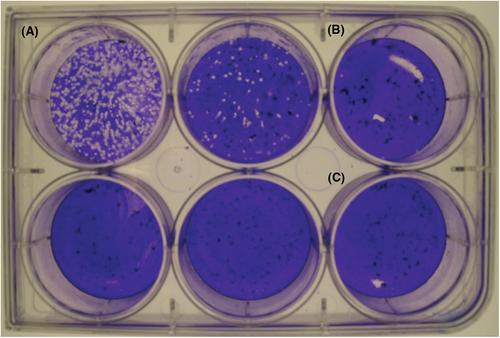下载PDF
{"title":"Two Detailed Plaque Assay Protocols for the Quantification of Infectious SARS-CoV-2","authors":"Emelissa J. Mendoza, Kathy Manguiat, Heidi Wood, Michael Drebot","doi":"10.1002/cpmc.105","DOIUrl":null,"url":null,"abstract":"<p>Severe acute respiratory syndrome coronavirus-2 (SARS-CoV-2) has been identified as the causal agent of COronaVIrus Disease-19 (COVID-19), an atypical pneumonia-like syndrome that emerged in December 2019. While SARS-CoV-2 titers can be measured by detection of viral nucleic acid, this method is unable to quantitate infectious virions. Measurement of infectious SARS-CoV-2 can be achieved by tissue culture infectious dose−50 (TCID<sub>50</sub>), which detects the presence or absence of cytopathic effect in cells infected with serial dilutions of a virus specimen. However, this method only provides a qualitative infectious virus titer. Plaque assays are a quantitative method of measuring infectious SARS-CoV-2 by quantifying the plaques formed in cell culture upon infection with serial dilutions of a virus specimen. As such, plaque assays remain the gold standard in quantifying concentrations of replication-competent lytic virions. Here, we describe two detailed plaque assay protocols to quantify infectious SARS-CoV-2 using different overlay and staining methods. Both methods have several advantages and disadvantages, which can be considered when choosing the procedure best suited for each laboratory. These assays can be used for several research purposes, including titration of virus stocks produced from infected cell supernatant and, with further optimization, quantification of SARS-CoV-2 in specimens collected from infected animals. © 2019 The Authors.</p><p><b>Basic Protocol</b>: SARS-CoV-2 plaque assay using a solid double overlay method</p><p><b>Alternate Protocol</b>: SARS-CoV-2 plaque assay using a liquid overlay and fixation-staining method</p>","PeriodicalId":39967,"journal":{"name":"Current Protocols in Microbiology","volume":"57 1","pages":""},"PeriodicalIF":0.0000,"publicationDate":"2020-05-31","publicationTypes":"Journal Article","fieldsOfStudy":null,"isOpenAccess":false,"openAccessPdf":"https://sci-hub-pdf.com/10.1002/cpmc.105","citationCount":"164","resultStr":null,"platform":"Semanticscholar","paperid":null,"PeriodicalName":"Current Protocols in Microbiology","FirstCategoryId":"1085","ListUrlMain":"https://onlinelibrary.wiley.com/doi/10.1002/cpmc.105","RegionNum":0,"RegionCategory":null,"ArticlePicture":[],"TitleCN":null,"AbstractTextCN":null,"PMCID":null,"EPubDate":"","PubModel":"","JCR":"","JCRName":"","Score":null,"Total":0}
引用次数: 164
引用
批量引用
Abstract
Severe acute respiratory syndrome coronavirus-2 (SARS-CoV-2) has been identified as the causal agent of COronaVIrus Disease-19 (COVID-19), an atypical pneumonia-like syndrome that emerged in December 2019. While SARS-CoV-2 titers can be measured by detection of viral nucleic acid, this method is unable to quantitate infectious virions. Measurement of infectious SARS-CoV-2 can be achieved by tissue culture infectious dose−50 (TCID50 ), which detects the presence or absence of cytopathic effect in cells infected with serial dilutions of a virus specimen. However, this method only provides a qualitative infectious virus titer. Plaque assays are a quantitative method of measuring infectious SARS-CoV-2 by quantifying the plaques formed in cell culture upon infection with serial dilutions of a virus specimen. As such, plaque assays remain the gold standard in quantifying concentrations of replication-competent lytic virions. Here, we describe two detailed plaque assay protocols to quantify infectious SARS-CoV-2 using different overlay and staining methods. Both methods have several advantages and disadvantages, which can be considered when choosing the procedure best suited for each laboratory. These assays can be used for several research purposes, including titration of virus stocks produced from infected cell supernatant and, with further optimization, quantification of SARS-CoV-2 in specimens collected from infected animals. © 2019 The Authors.
Basic Protocol : SARS-CoV-2 plaque assay using a solid double overlay method
Alternate Protocol : SARS-CoV-2 plaque assay using a liquid overlay and fixation-staining method
传染性SARS-CoV-2定量的两种详细空斑测定方案
严重急性呼吸综合征冠状病毒-2 (SARS-CoV-2)已被确定为冠状病毒病-19(2019年12月出现的一种非典型肺炎样综合征)的致病因子。虽然SARS-CoV-2滴度可以通过检测病毒核酸来测量,但这种方法无法定量感染性病毒粒子。传染性SARS-CoV-2的测量可以通过组织培养感染剂量- 50 (TCID50)来实现,该剂量检测连续稀释病毒标本感染的细胞是否存在细胞病变效应。然而,这种方法只能提供定性的感染病毒滴度。斑块分析是一种定量测量传染性SARS-CoV-2的方法,通过对病毒标本连续稀释感染后细胞培养中形成的斑块进行量化。因此,空斑测定仍然是定量具有复制能力的溶解病毒粒子浓度的金标准。在这里,我们描述了两种详细的空斑测定方案,使用不同的覆盖和染色方法来量化传染性SARS-CoV-2。这两种方法都有一些优点和缺点,在选择最适合每个实验室的程序时可以考虑。这些检测可用于多种研究目的,包括对受感染细胞上清产生的病毒库进行滴定,并进一步优化从受感染动物采集的标本中对SARS-CoV-2进行定量。©2019作者。基本方案:使用固体双覆盖层法进行SARS-CoV-2斑块测定。备用方案:使用液体覆盖层和固定染色法进行SARS-CoV-2斑块测定
本文章由计算机程序翻译,如有差异,请以英文原文为准。



